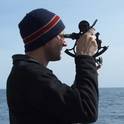In January 2011 the University of Rhode Island held a two day retreat for faculty and research scientists interested in where the field is going over the next 20 years. The retreat began with presentations detailing the current status and anticipated advances in genetics, nanotechnology, numerical modeling and robotics. Participants then outlined scientific problems that they expect will exist in 2030. This was followed by breakout sessions in which participants discussed experiments, based on anticipated technological advances, that might be undertaken in the 2030 time frame to address some of the identified problems. In this presentation we outline one of these experiments. The experiment was designed to quantify air-sea fluxes under high wind conditions following a wave train. We believe that not only will the processes involved remain poorly resolved in 2030 but also that they will become of increasing importance as the coupling and the spatial and temporal resolution of ocean and atmospheric models improves. The experiment outlined is based on a suite of unmanned submersible and air assets designed to sample the ocean, the atmosphere and the interface between the two.
Presentation
An Air-Sea Flux Experiment for 2030
2012 Ocean Sciences Meeting
(2012)
Abstract
Disciplines
Publication Date
February 21, 2012
Citation Information
Cornillon, P. C., Farmer, D., Roman, C., Ginis, I., & Grilli, S. (2012). An air-sea flux experiment for 2030. Poster presented at 2012 Ocean Sciences Meeting, Salt Lake City, Ut, 19-24 Feb.
